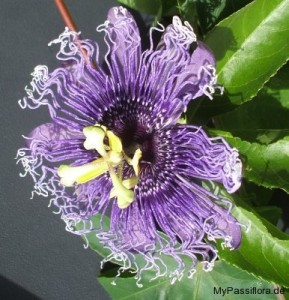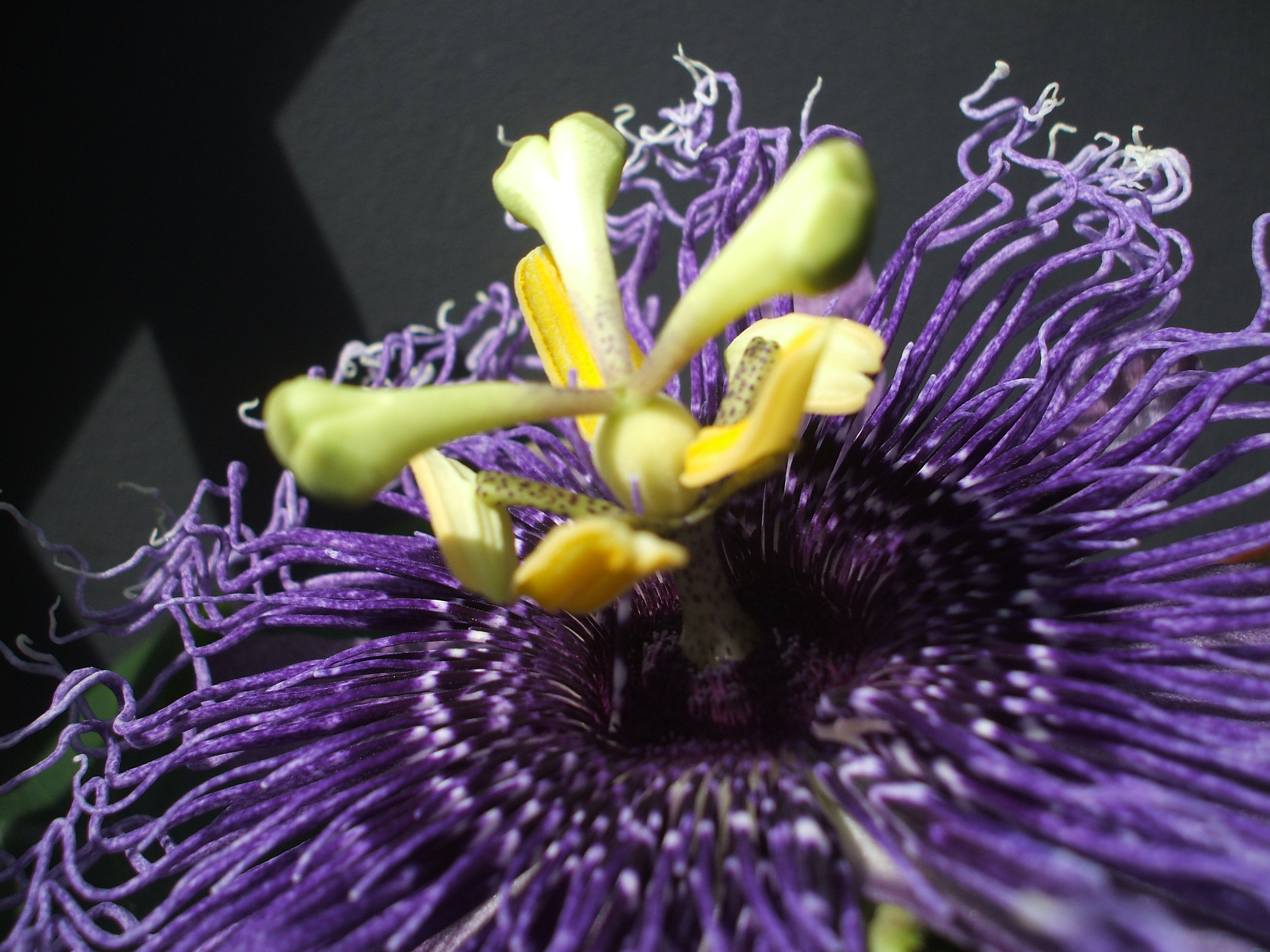 Passiflora ‚Byron Beauty Hybride‘ ist eine meiner eigenen Kreuzungen.
Passiflora ‚Byron Beauty Hybride‘ ist eine meiner eigenen Kreuzungen.
Die Identität des Bestäubers ist nicht zweifelsfrei geklärt, wahrscheinlich ist es aber Passiflora ‚Temptation‘, da zur fraglichen Zeit bei mir keine andere passende Passionsblume blühte.
Die Mutterpflanze ist nämlich eine komplizierte tetraploide Krezung mit folgender Formel: [(Passiflora edulis flavicarpa x Passiflora edulis edulis) x Passiflora incarnata] 4n.Züchter ist Robert J. Knight.
Eine tetraploide Passi kann aber nur durch Bestäubung mit einer anderen tetraploiden Passiflora fruchten, deshalb kommt bei mir letztlich nur P. ‚Temptation‘ als ebenfalls tetraploider Bestäuber in Frage.
Diese Passiflora ‚Byron Beauty‘-Hybride ist ein üppiges Erlebnis für die Sinne!
Die „blauen Wuschel“, wie ich sie nenne, und dazu zählen für mich nicht nur P. ‚Byron Beauty‘ und P. ‚Temptation‘, sondern auch alle anderen zahlreichen ähnlich aussehenden Hybriden, sind ein Festmahl für alle Sinne. Riesige leuchtend lila-blaue Blüten mit wild gekräuseltem Strahlenkranz sind schon optisch ein Hingucker. Doch damit nicht genug. Auch für den Geruchssinn sind sie ein Erlebnis. Der betörende, süßlich-fruchtige und intensive Duft, den sie an einem heißen Sommertag verströmen, hat für meine Nase Suchtpotenzial. Noch glücklicher ist, wem es gelingt eine der Blüten zu befruchten, denn die Früchte zählen zu den leckersten der Gattung Passiflora, die ich kenne. Sie schmecken so richtig intensiv nach Maracuja, super süß und aromatisch.
Unschwer zu erkennen, dass ich ein großer Fan der blauen Wuschel bin;)
Was es sonst noch zu der Passiflora zu sagen gibt: die ‚Byron Beauty‘-Hybride ist bedingt frostresistent, verträgt also vorübergehend leichte Minusgrade und kann bis zuletzt draußen bleiben, wenn es ans Einräumen im Winter geht. Gut zu wissen, wenn viele Pflanzen reinzuholen sind und ein Tag dafür nicht ausreicht…
Aufpassen muss man allerdings beim Einrollen oder Zusammenbinden der Ranken, denn sie knicken verdammt leicht, sind sehr unflexibel im Vergleich mit anderen Passionsblumen-Sorten.
Passiflora ‚Byron Beauty Hybride‘ is one of my self-bred crossings.
The identity of the pollinator is not quite clear, but most probably it’s Passiflora ‚Temptation‘, because at the time in question, no other compatible Passion Flower bloomed in my place. The female parent is a complex tetraploid cross having following formular: [(Passiflora edulis flavicarpa x Passiflora edulis edulis) x Passiflora incarnata] 4n. Breeder is Robert J. Knight. A tetraploid Passi can only be pollinated by another tetraploid Passiflora. Therefore, in my case, only P. ‚Temptation‘ is a compatible tetraploid pollinator.
This Passiflora ‚Byron Beauty‘ hybrid is an opulent experience for all senses!
The blue ‚Wuschel‘, as I call them („Wuschel“ is difficult to translate, means something like wispy or fizzy), and I refer to all kinds of similar-looking hybrids, not only P. ‚Byron Beauty‘ and P. ‚Temptation‘, are a feast for all senses. Big purple-blue flowers with curly corona are an eye-catcher. But also for the sense of smell, they are an experience. The captivating fragrance the flowers give off on a hot summer day is really addictive to my nose. I just can’t get enough of it. Even luckier you are if you get a ‚Byron Beauty‘ hybrid to set fruit. The fruits belong to the most yummy ones among the Passiflora fruits I have ever tasted. They taste intensively like Maracujy, super sweet and aromatic.
Plain to see, I’m a big fan of the blue Wuschels;)
What else is to say about this Passion Flower: the ‚Byron Beauty‘ hybrid is a bit hardier than most of the Passiflora species. So it can stay outside until it’s around zero degrees. When you have too many plants to take in the first really cold night in the beginning of winter, leave it outside and take it in the other day.
However, be careful winding-up the vines. They are quite inflexible, compared to other Passiflora species, and will easily buckle.
